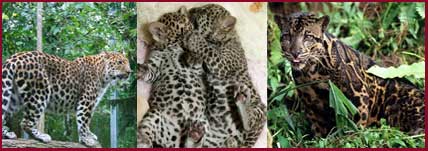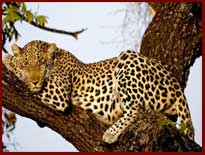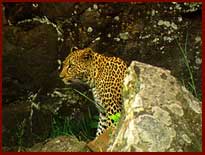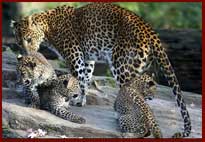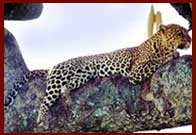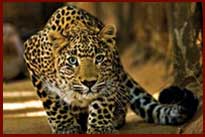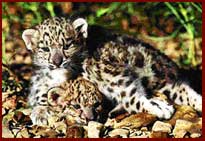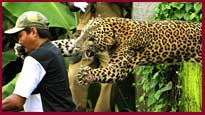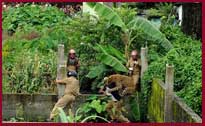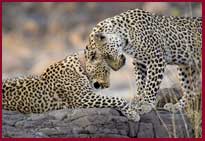Leopard
Introduction
Page 1 of 7
The Indian leopard or Tendua or Baghera with the zoological name "Panthera pardus fusca" is one of the leopard subspecies widely spread in India.
Like Asiatic lion and Bengal tiger, it also falls under the big cats family and rated as fourth largest among them. It is of the order Carnivora and the family Felidae. There are eight other subspecies of leopard (Panthera pardus) existing around the world. The name Leopard has been derived from the Greek and Latin words wherein the 'Leo' means Lion and the 'Pard' means Panther.
Physical Structure
The cunning and most powerful Indian leopards have lengthened muscular body with a longer tail measuring 3 feet. The spots on the leopard make it unique from other animals and are called as 'Rosettes', since they resemble the shape of a rose. The spots can be of dark brown or black on the leopard's coat which has a background color of pale, creamy yellow to chestnut.
Small dark spots can be seen in various areas like ears, face, head, throat, chest and legs and large spots can be seen around the belly. The inner limbs have pale colored spots. These cats have broad paws, small eyes and short ears. The skin may become shorter and sleeker during the sunny season and tend to be longer and denser during the cold climate. Like other animals, males are larger than the females and weighs about 60 kg and grows 65 cm tall while female ones weigh 40 kg and grows up to 50 cm tall.
Leopards are agile climbers, strong swimmers and skillful stalkers. They are difficult to be spotted even though they live practically among humans. They are elegant and silent. Amongst all the big cats they are probably the most talented stalkers. They are good, flexible climbers and can slide down from a tree rapidly. Although leopards are mainly nocturnal they can be found roaming in their places during the daytime searching for their prey.
Page 2 of 7
They can be seen solitary, avoiding herds. Occasionally, at maximum only 3 or 4 leopards can be seen together.
They have an excellent hearing and vision sense which are extremely acute. In the day time they can be seen lying in the bush, on the rocks or in the tree in a comfortable way in order to laze and warm them. Their strength, elegant, flexibility, silent nature and ability to swim and climb and many other characteristics took these clever animals to the top position to survive amongst other carnivores.
Places found:
Bandhavgarh National Park:
Bandhavgarh National Park is located at Madhya Pradesh, India with an area of about 450 square kilometers. The thick forest of Bandhavgarh National Park sits in between the cliffs of the Vindhyan Mountains. The forest has the wild attractions like Indian leopard, Elephants, Tiger, Nilgai, Chausingha, Chital, Chinkara, Indian Muntjac Chital, Sambar, Wild Boar and Fox or Golden Jackal. Elephant safari and Jeep safari are conducted in order to view all the wildlife of Bandahavgarh National park.
Jim Corbett National Park: The Jim Corbett National Park is located in Ramnagar in the district of Nainital, Uttaranchal, at the foothills of Himalayas. The biggest attraction in this park is the wide variety of wildlife, breathtaking natural vegetation and trekking trails. The usual way to explore the Jim Corbett's park is through the Jeep or Elephant safaris. It is the most popular tourists' place. It is the house of about 50 species of mammals, variety of faunas and floras. The most common animals are Leopard, Deer, Royal Bengal tiger, Indian elephants, Para or Hog Deer, Barking deer, Wild boar, Chital, etc.
Kanha National park: The Kanha National park located in Mandla, Madhya Pradesh is famous as a tiger reserve and a national park with an area of 1,067 kms. The park has a population of Royal Bengal Tiger, Leopard, bear, Python, Pea fowl, Hare, Monkey and Indian wild dog. Elephant safari and Jeep safari are conducted in order to view all the wildlife at Kanha National park.
Sariska Tiger Reserve: The Sariska Tiger Reserve is a national park in India located in the Alwar district of Rajasthan. The park is situated at a distance of 107 km from Jaipur and 200 km from Delhi. This area was a hunting reserve and it was declared a wildlife reserve in 1955. In 1978, the park was given the rank of a tiger reserve making it a part of India's Project Tiger system.
Page 3 of 7
Ranthambore Tiger Reserve: The Ranthambore Tiger Reserve located in Rajasthan is one of the largest national parks in Northern India with an area of 392 kms.
The touristers here can sport various fauna like Leopards, tigers, sloth bears, hyena, cats, etc. Jeep and bus safaris are arranged for the touristers to view the game in Ranthambore Tiger reserve.
The current area of the park is 866 kms. Most commonly spotted carnivores here are leopard, Bengal tiger, wild jackal, wild dog, sambhar, chital, hyena, wild cat, nilgai, wild boar, etc.
Sundarbans National Park: The Sundarbans National Park is a National Park, UNESCO World Heritage Site and a Biosphere Reserve located in the Sundarbans delta in the Indian state of West Bengal. It has an awe-inspiring flora with about 58 species of mammals. Most commonly spotted carnivores here are Leopards, Bengal tiger, rhinoceros, wild hogs, wild buffaloes, wild cats, monkeys, barking deer, etc.
Gir National Park: The Gir National Park is situated in Gujarat with an area of 120 square-miles with rich flora and habitat. Primarily, it is the home for Lions and has the largest leopard population compared to other national park in India. Leopards can be seen at the border of the park during the summer seasons. Other Wildlife here includes Sambar deer, Chital, Jackal, Hyena, and Langur Monkeys. Jeep safari is conducted in order to view all the wildlife at Gir National park.
Food Habits:
Indian Leopards are very clever and carnivorous animal. They are not selective about their prey and may hunt any animal. They eat anything they can kill right from insects to large cattle. Their prey may include monkeys, jackals, antelopes, reptiles, amphibians, birds, fish, wild pigs, wild boars, baboons, storks, reed-bucks, impalas, wild dogs, and domestic pets like goat, cows and many more depending on their habitat.
Their hunting behavior is that they usually attack the victim from behind and clamp their jaws down the neck and throat of the prey. If fortunately the prey absconds, one could see the bite marks in the nape of the neck and the throat. In recent days, the reports of leopards attacking humans have also been shocking.
Page 4 of 7
Mating Behaviour
Indian leopards mate throughout the year. Usually these cats are territorial and solitary.
Only during the breeding season they can be seen in pairs. The estrous cycle lasts about 46- 50 days and the female is under warmth for about 6 to 7 days. In a single delivery it can give birth to 2-3 cubs. The male accompanies the female throughout the gestation period and two to four months after the birth of cubs.
New borns open up their eyes between ninth and tenth day of the birth. The cubs start to join their mother in hunts after the period of three months from birth and stays with her for about 18 to 24 months. Indian Leopards live in captivity for about 21 - 24 years which is interrelated with the amicable habitat to live in. Its lifespan in wild lasts for about 7 to 9 years which is because of the various reasons like poaching and other related threats.
Subspecies of Indian Leopard:
| Common name |
Zoological name |
Found at |
IUCN listing |
| African Leopard |
Panthera pardus pardus |
Africa |
None |
| Persian or Iranian Leopard |
Panthera pardus saxicolor |
Central Asian |
Endangered |
| Indian Leopard |
Panthera pardus fusca |
India |
Endangered |
| Sri Lanka Leopard |
Panthera pardus kotiya |
Srilanka |
Endangered |
| Indo-Chinese Leopard |
Panthera pardus delacouri |
Indochina |
None |
| North China Leopard |
Panthera pardus japonensis |
China |
Endangered |
| Amur Leopard |
Panthera pardus orientalis or amurensis |
Amur Region, border Russia, China, North Korea |
Critically endangered. |
| Javan Leopard |
Panthera pardus melas |
Java |
Endangered |
| Arabian Leopard |
Panthera pardus nimr |
Arabia |
Endangered |
| Anatolian Leopard |
Panthera pardus tulliana |
Turkey |
critically endangered |
| Barbary Leopard |
Panthera pardus panthera |
Algeria and Egypt |
critically endangered |
| Caucasus Leopard |
Panthera pardus ciscaucasica |
Caucasus |
critically endangered |
| Sinai Leopard |
Panthera pardus jarvisi |
Sinai Peninsula |
critically endangered |
| Zanzibar Leopard |
Panthera pardus adersi |
Unguja Island |
critically endangered |
| Kashmir leopard |
Panthera pardus millardi |
Kashmir |
Near threatened |
| |
Panthera pardus pernigra |
Nepal & Kashmir |
Near threatened |
Page 5 of 7
There were more than 20 subspecies of leopard existing throughout the world but recent estimates report that only the above subspecies exists and they have an IUCN listing ranging from Endangered to near threatened.
Population of Leopards in India:
he recent wild life census conducted in India has figured out the leopard population as 1,150 which have an increase of about 70 to 80 leopards as compared to the 2006 census. The estimation states that there is an increase in population of about 10% to 20% in Gir Sanctuary located in Gujarat. It is expected by the forest department officials for an increase in number of leopards of about 10% to 15%. There are also leopards staying in human settlement which ranges about 160 to 170.
Threats to Indian leopard:
The pre-eminent threat faced by Indian leopards is the loss of habitat and fragmentation, degradation and the human-leopard conflict when leopards enter into human settlements. The threats may include poaching, human-leopard conflict, and competition between the carnivores for prey. IUCN has rated it as a critically endangered species on earth.
Poaching:
Poaching is a major threat which majority of the wild life are facing. The Indian leopards are hunted for the illegal trade of pelt and fur. Since the government was so liberal in taking an action against these wild life threats, it has been encouraging for the poachers to organize camps in various areas to plunder the skins of the wild leopards.
The skins are half cured and supplied to dealers, who further hand over for the tanning. These tanned products are then sent for sale through smugglers. A raid in India revealed that around 2900 leopards has been poached during the period of 1994 and 2010 and 3,200 leopards have been killed since 1995.
Page 6 of 7
Human-leopard Conflict:
Due to the increase in human population the extension of agriculturally used land, intrusion of humans and their
livestock into protected areas are main factors contributing to habitat loss, increase in population and decrease of wild prey.
Eventually, due to the above instance leopards enter into the human areas and have been tempted to hunt the live stocks like pigs, dogs, goat, cow, etc. At this point of time, the Human leopard conflict arises and they are killed brutally. There are recent dreadful cases where the leopards attack human for their food.
Competition with other predators:Indian wild Leopards live with other wild animals like Asiatic lions, Bengal tigers, Asiatic Black Bears and sloth bears and many others. If left unnoticed these wild animals can prey the leopard cubs. The full-grown leopards can be preyed by Asiatic Lions and Bengal tigers.
Conservation effort in India:
As per the Convention on International Trade in Endangered Species of Wild Fauna and Flora (CITES), the Indian leopards have been classified as the species of extinction due to illegal trade. With reference to it CITES has stated that, Management Authority of the exporting state must provide the permit for both import and export of these species.
In order to stop the Leopard extinction, India has taken steps to make people understand the importance of the wildlife, role in saving the Nation's biodiversity, ways to minimizing the human-leopard interaction and impacts of poaching the creatures.
Leopard as a symbol in various religions:
In general, the leopard is a symbol of gallant, self confidence, agility, and is a strong warrior. Leopard skins were worn by priests of various religions to guard from evil spirits. Leopard is the national animal of Somalia.
Page 7 of 7
Interesting Facts:
1.The leopard's call is addressed as 'saw'. This call can be described as a short rasping vocalization.
2. It has the ability to run to a maximum speed or move up to approximately 58 kilometers per hour (36 miles per hour)
3. The Head and body of Indian leopard varies from 3 to 6.5 ft (1.3 to 1.9 m) and tail ranges from 3.5 to 4.6 ft (0.6 to 1.4 m) in length.
4. It weighs about 30 to 80 kg (66 to 200 lbs).
5. The height of Indian leopard is usually 2 meters.
6. Leopards have the capability to hunt from trees unlike other animals.
7. It is the smallest of the big cats.
8. Leopards can pull up to thrice their own body weight to a tree and place it on branches over 6 m (19.7 ft) high.
9. They can survive without water for longer period, receiving all the moisture they need from their prey.
